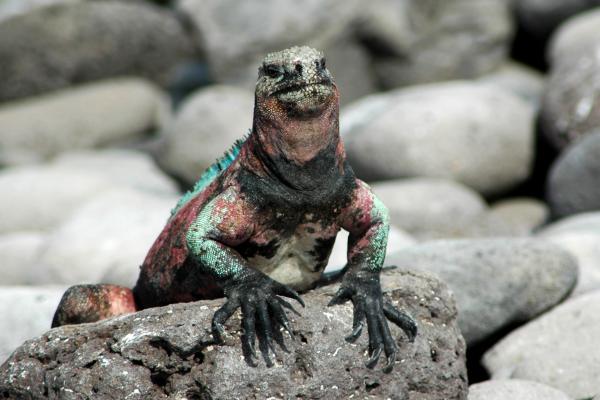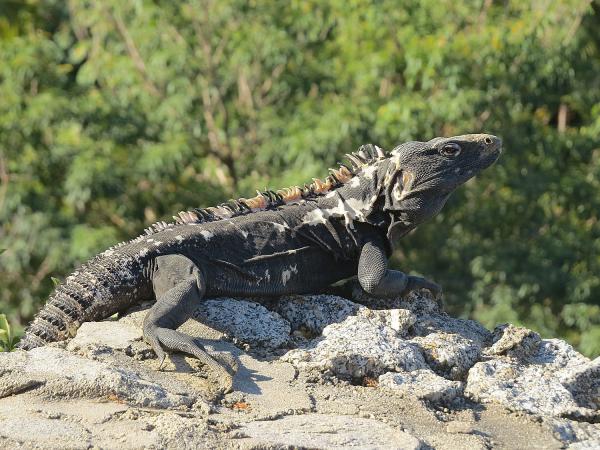Iguanas belong to the family Iguanidae, a group of diurnal reptiles that can be terrestrial, arboreal, or semi-aquatic. They are primarily distributed in the Americas, though two genera are also found in Madagascar and Fiji. Based on current taxonomy, the Iguanidae family includes the following genera:

Amblyrhynchus: 1 species (Galápagos Islands)
Brachylophus: 2 species (Vanuatu and Fiji)
Conolophus: 3 species (Galápagos Islands)
Ctenosaura: 14 species (Central and North America)
Cyclura: 10 species (Caribbean)
Dipsosaurus: 1 species (North America)
Iguana: 2 species (Central & South America, Caribbean)
Sauromalus: 6 species (North America)

Also known as the common iguana, this arboreal lizard can reach up to 2 meters in length and weigh as much as 15 kg. It is native to the Americas and ranges from Mexico to Paraguay and Brazil through Central and northern South America. Found mainly in tropical rainforests and mangroves, it also adapts to arid regions.
Primarily herbivorous (leaf-eating), it nests in underground burrows. Its body is covered in green scales, with a prominent dorsal crest, especially noticeable in males.

Endemic to the Lesser Antilles, this species inhabits xeric scrublands, coastal and riverine forests, and mangroves. It is a generalist herbivore, feeding on leaves, flowers, and fruits, occasionally eating meat like its cousin, the green iguana.
The introduction of invasive Iguana iguana and habitat destruction have drastically reduced its population. It is now listed as Critically Endangered by the IUCN.

Native to the Galápagos Islands, it is the only marine-adapted iguana and the only species in its genus. Lives mostly on rocky coasts but can be found on beaches and in mangroves. Feeds on marine algae and swims in the ocean—only adult males dive due to their larger size (2–3 meters long).
Excess salt is excreted via nasal glands. It’s the only iguana species to use lek mating systems, where dominant males defend small territories. Classified as Vulnerable by the IUCN.

Endemic to the Galápagos archipelago, it inhabits arid, sparsely vegetated areas. Feeds on over 30 plant species, obtaining moisture primarily from Opuntia cacti. Occasionally eats insects or carrion.
Plays a key role in seed dispersal. All populations reside in protected areas like the Galápagos National Park and Marine Reserve, where goat and feral predator control programs are active.

Native to western Mexico, found in dry deciduous forests, rocky outcrops, and coastal ravines. Introduced to Texas and Florida. Grows up to 1.2 meters. Its scales are black with yellowish or whitish irregular markings.
Diurnal and omnivorous, it eats leaves, fruits, insects, and small mammals or birds. Hunted for food and threatened by habitat fragmentation, it holds cultural and economic value for local communities.

One of the smallest iguana species, maxing out at 60 cm. Has bright green coloration with bold vertical bands and a darker tail. Arboreal, inhabiting moist and dry forests on Fiji’s Aiwa and Vuaqava islands (both uninhabited). Found in Tonga, but likely introduced.
Now Endangered due to invasive species, deforestation, and illegal capture.
animal tags: Iguanas
We created this article in conjunction with AI technology, then made sure it was fact-checked and edited by a Animals Top editor.